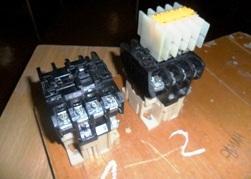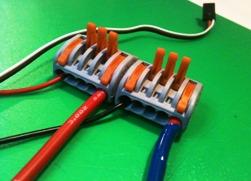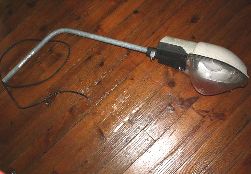What is the difference between a contactor and a starter?
 Even the most experienced electrician engineers and just specialists with higher education do not always explain the fundamental difference between a starter and a contactor. Let's try to figure it out on our own.
Even the most experienced electrician engineers and just specialists with higher education do not always explain the fundamental difference between a starter and a contactor. Let's try to figure it out on our own.
The common thing between the contactor and the starter is that both of them are intended for switching circuits, usually power ones. Therefore, contactors and starters are often used to start AC motors.
In addition to the power contacts, both the contactor and the starter necessarily include at least one (and most often far from one) pair of contacts for the control circuit: normally closed or normally open. These contactors and starters are similar. But how do they nevertheless differ? ...
Application of a frequency converter and voltage regulator in suburban water supply systems
 This article discusses the use of a frequency converter and a voltage regulator to solve the problem of managing a suburban water supply system.
This article discusses the use of a frequency converter and a voltage regulator to solve the problem of managing a suburban water supply system.
As an object of automation, a house was selected in a suburban cottage village, connected to a central water supply. The main disadvantage of the central water supply system in the village is the inconsistency of water pressure, in a very wide range of 0.5-1.8 atm, which by itself is not enough to comfortably take a shower or to water the entire garden at the same time.
The customer was asked to modernize the current water supply system, make an effective system for regulating the outlet pressure in the cottage and automate the irrigation system of the garden ...
How are the WAGO terminal blocks arranged?
 In European countries, terminal blocks Wago are the most popular way to connect wires. We still treat them with very great suspicion, although everyone who is professionally involved in the installation of household electrical wiring knows about them. Terminals, connectors, blocks "Vaga", "Vagi" is already firmly included in the dictionary of a modern electrician.
In European countries, terminal blocks Wago are the most popular way to connect wires. We still treat them with very great suspicion, although everyone who is professionally involved in the installation of household electrical wiring knows about them. Terminals, connectors, blocks "Vaga", "Vagi" is already firmly included in the dictionary of a modern electrician.
In this article, let's understand how the terminal blocks are arranged. Wago. We will deal with the example of the most popular and universal series - WAGO 222. These terminal blocks Pare applied for connecting branches of copper single and multicore conductors in AC circuits with a maximum voltage of 380V and a frequency of 50 Hz. TOlemmenicki WAGO 222 can be used both for connecting lighting equipment and for installation in junction boxes ...
Can the use of energy-saving lamps cause an environmental disaster?
 It is no secret that for a long time every house has energy-saving lamps, which are undoubtedly more economical than conventional incandescent lamps. With all the advantages of energy-saving lamps, they also have a significant drawback - these lamps contain mercury. Vapors of this heavy metal can cause serious poisoning.
It is no secret that for a long time every house has energy-saving lamps, which are undoubtedly more economical than conventional incandescent lamps. With all the advantages of energy-saving lamps, they also have a significant drawback - these lamps contain mercury. Vapors of this heavy metal can cause serious poisoning.
The problem of recycling and recycling energy-saving lamps unsuitable for use is being actively addressed. There are regulations that clearly regulate the fact that all available energy-saving lamps must be recycled.
Such attention to this type of waste is due to the mercury content sufficient for poisoning (2 - 7 grams), especially indoors. Imagine if you have a lot of such lamps in your home or in a landfill ...
An example of using a metal detector to search for hidden wiring
 At one of the facilities where I carried out electrical work on the “inside”, that is, the installation of internal electrical wiring, I needed to find where the wires pass under the plaster.
At one of the facilities where I carried out electrical work on the “inside”, that is, the installation of internal electrical wiring, I needed to find where the wires pass under the plaster.
The fact is that the client suddenly decided to make a suspended ceiling from drywall and its level was just located in the area of the laid electrical wiring under the plaster. Unfortunately, the “unfortunate builders” have already managed to drill wiring in one place. I had to redo it. And to show them where to make holes for the dowel, I needed a device to detect hidden electrical wiring.
Unfortunately, such an instrument was not in my arsenal and I went to the store, hoping to get it there. The choice turned out to be small, or rather there was no choice at all ... Only a metal detector was available to detect pipe and current conductors ...
Wago terminal blocks in home wiring
 Here is a seemingly simple question: “How to connect cable cores in home wiring?” Meanwhile, when it occurs, it usually causes controversy among electricians.
Here is a seemingly simple question: “How to connect cable cores in home wiring?” Meanwhile, when it occurs, it usually causes controversy among electricians.
Simple twist? - Forbidden and unreliable. Welding wires? - It seems to be reliable, but PUE still requires certified clamps. PPE caps? - Many do not trust them, believing that they are no better than twisting with electrical tape. ZVI insulated screw clamps? - Big and not very comfortable.
It seems that if all the electricians were well acquainted with the WAGO terminal blocks, these disputes would be less. What are the advantages of these terminals, and how are they good? The main feature of the WAGO terminal blocks is that they are screwless. The design of a screwless terminal connection was developed at the German company WAGO back in 1951 ...
Temperature sensors. Part two. Thermistors
 The first part of the article briefly described the history of various temperature scales and their inventors Fahrenheit, Reaumur, Celsius and Kelvin. Now it’s worth getting acquainted with temperature sensors, the principles of their operation, devices for receiving data from these sensors.
The first part of the article briefly described the history of various temperature scales and their inventors Fahrenheit, Reaumur, Celsius and Kelvin. Now it’s worth getting acquainted with temperature sensors, the principles of their operation, devices for receiving data from these sensors.
In modern industrial production, many different physical quantities are measured. Of these, the mass and volume flow rate is 15%, the level of liquids is 5%, the time is not more than 4%, the pressure is about 10%, and so on. But the temperature measurement is almost 50% of the total number of technical measurements.
Such a quantity not only speaks of a wide variety of measuring instruments and, as a result, a multitude of primary transducers and temperature sensors, as well as constantly increasing requirements ...
How to lay the cable in the courtyard of the house
 In the practice of housekeeping, it is often necessary to connect some devices or structures located near the house. Electricians call this process branching. For example, it can be a garage, a trading stall, a street lamp or just a canopy with lighting (a gazebo in the garden).
In the practice of housekeeping, it is often necessary to connect some devices or structures located near the house. Electricians call this process branching. For example, it can be a garage, a trading stall, a street lamp or just a canopy with lighting (a gazebo in the garden).
Let's try to consider various ways of creating a branch or in an understandable language for laying an additional electrical cable. According to established practice, the power line from which the branch will be made is most often air. In some cases, an underground branch is used. Air lines in most cases are more reliable, because their damage can be detected visually and, if so, they are restored much faster than underground ...
